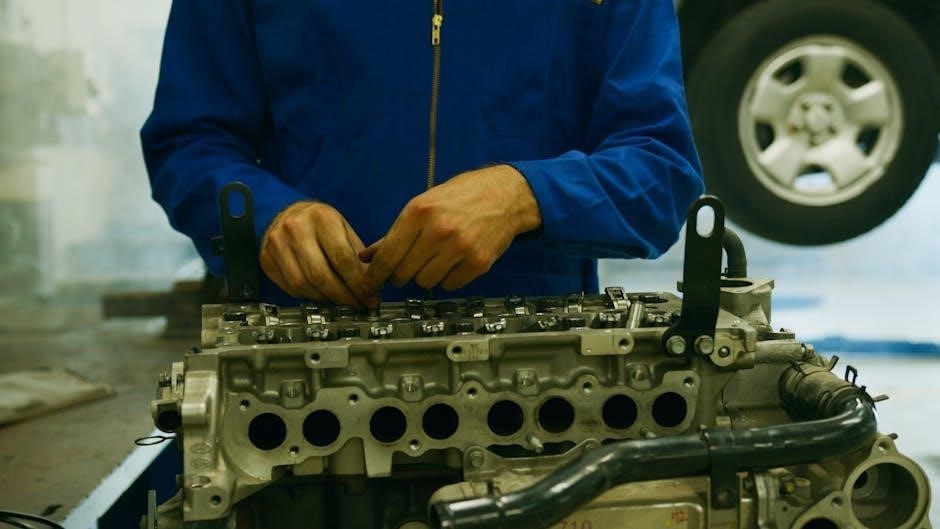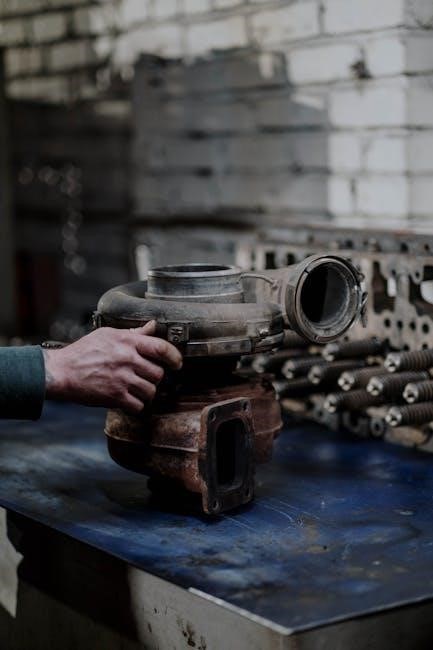Manual motor starting with a rheostat offers a straightforward method to control motor speed and torque. By adjusting resistance, it provides smooth acceleration and efficient operation.
1.1 Overview of Rheostat-Based Motor Starting
Rheostat-based motor starting involves using a variable resistor to regulate current flow to the motor. This method allows smooth acceleration by gradually reducing resistance. It is commonly used in DC motors and provides a cost-effective solution for controlling speed and torque. The system’s simplicity makes it ideal for industrial applications requiring precise manual control. Rheostats are connected in series with the motor, enabling operators to adjust resistance and manage startup conditions effectively.
1.2 Importance of Manual Control in Motor Systems
Manual control in motor systems ensures precise operation and safety, allowing operators to directly manage startup and speed. This method is crucial for systems requiring human oversight, offering reliability and adaptability. Manual control enables smooth acceleration, reduces wear on components, and provides a fail-safe mechanism in automated environments. It is particularly valuable in industrial settings where precise adjustments are necessary for optimal performance and efficiency.

What is a Rheostat?
A rheostat is a variable resistor used to control electrical resistance and current flow in a circuit. It adjusts voltage and regulates motor speed effectively.
2.1 Definition and Function of a Rheostat
A rheostat is an adjustable resistor that controls the flow of electrical current in a circuit. Its primary function is to vary resistance, allowing precise regulation of voltage and current. Widely used in motor systems, rheostats enable smooth speed and torque adjustments during startup and operation. Their simplicity and effectiveness make them a reliable choice for manual motor control applications.
2.2 Types of Rheostats Used in Motor Control
Rheostats vary in design to suit different motor applications. Linear rheostats adjust resistance smoothly, while stepped rheostats use discrete resistance levels. Liquid rheostats, employing brine or electrolytes, offer high current handling. Each type balances cost, precision, and durability, ensuring reliable motor control in various industrial settings, from simple DC motors to complex induction systems, providing tailored solutions for specific operational needs and performance requirements.

The Manual Starting Process
Manual motor starting with a rheostat involves adjusting resistance to control current and voltage, ensuring smooth acceleration and preventing excessive current draw.
3.1 Preparing the Motor and Rheostat for Startup
To prepare the motor and rheostat, first ensure the motor is disconnected from any load; Set the rheostat to its minimum resistance position. Check all electrical connections for security and integrity. Verify the motor’s field rheostat is properly configured for startup. Ensure no external switches are engaged. This setup ensures a smooth and safe manual starting process with optimal control over current and voltage.
3.2 Step-by-Step Procedure for Manual Starting
Ensure the rheostat is set to minimum resistance. Turn off the motor and disconnect any load. Verify all connections are secure. Switch on the power supply and gradually increase the rheostat resistance. Monitor current and voltage to avoid overload. Once the motor reaches desired speed, maintain the rheostat setting. For stopping, reverse the process, reducing resistance to zero before disconnecting power.

Advantages of Manual Rheostat-Based Starting
Manual rheostat-based starting offers simplicity, cost-effectiveness, and smooth control. It requires minimal components, reducing initial investment and maintenance needs, making it ideal for various applications.
4.1 Simplicity and Cost-Effectiveness
Manual rheostat-based starting is inherently simple and cost-effective. It uses fewer components compared to advanced systems like VFDs, reducing both initial and maintenance costs. The rheostat’s straightforward design allows for easy installation and operation, making it a budget-friendly solution for motor control. Its simplicity also minimizes the need for complex programming or specialized skills, ensuring accessibility for a wide range of industrial and small-scale applications.
4.2 Smooth Acceleration and Control
Manual motor starting with a rheostat ensures smooth acceleration by adjusting resistance, providing precise control. This method is ideal for applications requiring gradual speed increases to prevent mechanical stress and ensure efficient operation. The rheostat’s ability to regulate current flow effectively minimizes sudden jerks, making it suitable for delicate machinery. Operators can easily manage the motor’s speed, ensuring optimal performance and longevity of the equipment.

Applications of Rheostat-Based Motor Starting
Rheostat-based motor starting is widely used in industrial machinery and equipment, such as pumps and conveyors, ensuring smooth operation and precise control for various applications.
5.1 Industrial Uses
Rheostat-based motor starting is commonly employed in industrial settings for controlling motors in pumps, conveyors, and machinery. It ensures smooth acceleration and efficient operation, reducing wear on equipment. Liquid rheostats are often used for large drives, while solid-state rheostats offer precision control. This method is ideal for applications requiring adjustable speed and torque, making it a reliable choice in manufacturing and process industries where precise motor control is essential for productivity and safety.
5.2 Specific Examples in Machinery and Equipment
Rheostat-based starting is widely used in pumps, fans, and conveyors to regulate speed and torque. In irrigation systems, liquid rheostats smooth motor acceleration, protecting equipment from sudden starts. Heating systems utilize rheostats for precise temperature control, while industrial machinery employs them for adjustable speed operation. These applications highlight the versatility and effectiveness of rheostat-based motor starting in ensuring efficient and reliable performance across diverse equipment and machinery.

Safety Considerations
Ensure all components are in the correct position before startup. Regularly inspect wiring and resistors to prevent faults. Always use protective gear when handling electrical systems.
6.1 Risks Associated with Manual Starting
Manual starting with a rheostat poses risks such as electrical shocks, overheating, and motor damage from improper resistance settings. Inadequate insulation or faulty wiring can lead to short circuits. Additionally, sudden voltage spikes or lack of feedback mechanisms may cause unpredictable motor behavior. Operators must be trained to handle emergencies and ensure all safety protocols are followed to minimize these risks and maintain system integrity during startup.
6.2 Best Practices for Safe Operation
Ensure the rheostat is properly configured and insulated to prevent electrical hazards. Always wear protective gear, including gloves and safety glasses. Conduct regular inspections of wiring and connections before startup. Follow manufacturer guidelines for resistance settings and startup procedures. Maintain proper grounding to prevent shocks. Keep emergency shutdown mechanisms accessible. Train operators on safe practices to minimize risks during manual motor starting with a rheostat.

Maintenance and Troubleshooting
Regularly clean and inspect the rheostat and motor connections to ensure proper function. Replace worn or damaged components promptly. Check for overheating and unusual noise during operation.
7.1 Regular Maintenance of Rheostat and Motor
Regular maintenance ensures optimal performance of the rheostat and motor. Inspect connections for cleanliness and tightness, and clean or replace worn parts. Lubricate moving components periodically. Check resistance levels and adjust as needed. Monitor for overheating or unusual noises, addressing issues promptly. Ensure all electrical contacts are secure and free from corrosion. Schedule routine checks to maintain efficiency and prevent unexpected failures.
7.2 Common Issues and Solutions
- Overheating: Ensure proper cooling and check the rheostat’s current rating.
- Worn Contacts: Regularly clean and replace worn parts to maintain conductivity.
- Incorrect Settings: Calibrate resistance according to motor specs for optimal performance.
Comparison with Other Starting Methods
Rheostat-based starting is simpler and cost-effective compared to VFDs, offering smooth control without complex electronics, making it ideal for basic motor applications.
8.1 Rheostat vs. Variable Frequency Drives (VFDs)
Rheostats offer a cost-effective, straightforward solution for motor starting, while VFDs provide precise speed control and energy efficiency. Rheostats are simpler but less flexible, lacking the advanced features of VFDs. VFDs excel in dynamic applications, offering variable speed and torque control, whereas rheostats are better suited for basic, fixed-speed operations. The choice depends on the application’s complexity and requirements.
8.2 Advantages of Rheostat Over Traditional Starters
Rheostats provide smooth acceleration and reduce inrush current, minimizing motor stress. They are cost-effective, easier to maintain, and offer simplicity in control. Unlike traditional starters, rheostats allow gradual speed adjustment, enhancing operational flexibility. This makes them ideal for applications requiring basic speed control without the complexity of advanced systems. Their durability and low maintenance further add to their appeal in industrial settings. Rheostats thus offer a reliable, efficient solution for motor starting.
Manual motor starting with a rheostat is a reliable and cost-effective method, offering smooth acceleration and simplicity in motor control, making it ideal for various industrial applications.
9.1 Summary of Key Points
Manual motor starting with a rheostat is a straightforward and economical method for controlling motor speed and torque. It ensures smooth acceleration, reducing mechanical stress on equipment. The system’s simplicity and cost-effectiveness make it a preferred choice for industrial applications. Rheostat-based starting offers precise control, easy installation, and minimal maintenance compared to complex alternatives like VFDs. This method remains a reliable and efficient solution for various motor-driven systems, balancing performance and affordability effectively.
9.2 Future Prospects for Rheostat-Based Systems
Rheostat-based motor starting systems are expected to remain relevant due to their simplicity and cost-effectiveness. Emerging technologies may integrate rheostats with smart controls for enhanced efficiency. Improved materials and designs could further optimize performance and durability. As industries prioritize energy efficiency, rheostat systems may evolve to meet new demands while maintaining their reliability in various applications.
